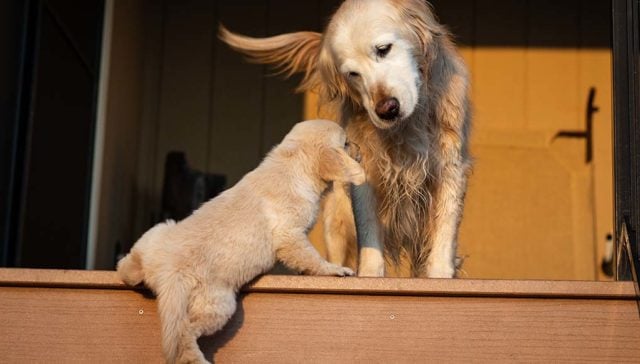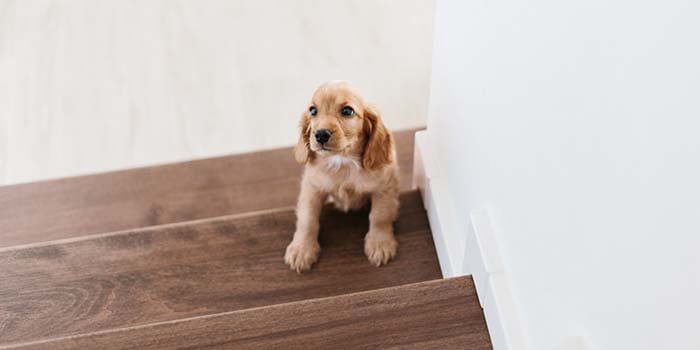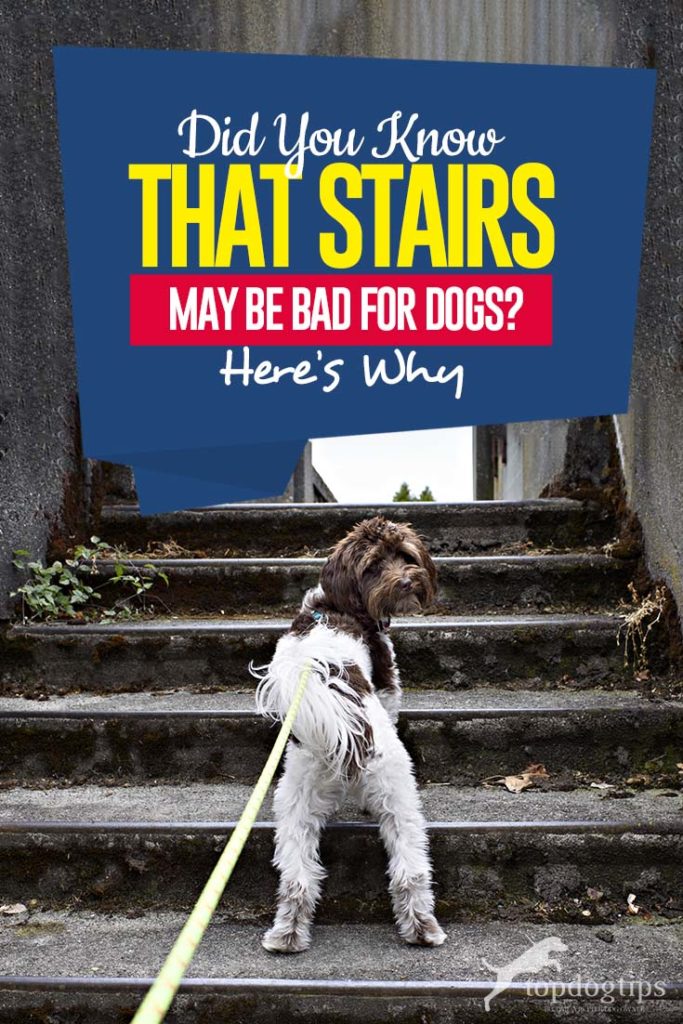
Table of Contents
Are stairs bad for dogs?
It's likely that the sound of your dog hammering up and down stairs will be common if you live in a home with stairs.
With some dogs and owners, indoor and outdoor stairs carry a notorious label.
But are stairs bad for dogs at all times, and should your pup avoid using them?
This question has many answers; it mostly depends on the individual dog and the circumstances surrounding them.
Here are some of the considerations to take into account.
Let's get started!
4 Cases When Stairs Pose Danger to Dogs
1. Dogs with Genetic Physiological Issues
Small breeds built with short legs and long spines, such as the Dachshund and Basset Hound, are at more serious risk of injury with prolonged stair usage.
Dogs with this physiological build are prone to ruptured disk syndrome or Intervertebral Disc Disease (IVDD), where even the slightest jolt to their spine (like ones sustained during hopping up and down the stairs) can cause a painful injury.
Breeds with elongated spines also find it difficult to remain balanced when descending steps which can also lead to slips, falls, and serious injuries.
2. Dogs with (Specific) Health Issues
If your dog suddenly stops using stairs, it may be a sign of a health issue.
Older dogs develop arthritis in their joints which can make ascending and descending the stairs painful.
Hip dysplasia is common in many medium and large breeds like Golden Retrievers or Great Danes.
This condition is characterized by a malformation of the hip's ball-and-socket joint, which, over time, causes excessive erosion of the dog's hip bones, leading to extreme pain.
3. Dogs with Injuries
Several types of injuries could keep your dog from using the stairs and may even aggravate the situation if left unsupervised.
Pulled muscles in the leg, a lacerated paw, or even an operation like routine spaying where stitches are used can all make climbing the stairs painful and dangerous for dogs.
If a vet has fitted your pup with a cone around their neck, these can also become a tripping hazard.
4. Senior Dogs
Stairs can be bad for older dogs for a number of reasons.
Senior dogs may develop poor eyesight, balance, and mobility issues due to arthritis or other health issues, as well as having to eliminate more often.
These conditions can all lead to falls or injuries from having to navigate indoor and outdoor steps.
Stairs for Puppies
Learning to walk up and down the stairs is already a daunting task for a puppy, but it can also pose some risks.
Small breed puppies may lose their footing, resulting in a tumble.
Depending on the breed of the dog, age, and the severity of the fall, your pup could be left with broken bones, spine issues, head injuries, sprains, or psychological fear of the steps.
Experts recommend introducing steps to your small puppy no earlier than 12 weeks old.
Large breeds are genetically more prone to hip dysplasia and arthritis.
Stairs for puppies of these breeds can make these conditions worse and/or speed up their development.
Give your puppy at least a year before they are allowed to navigate a staircase on their own.
Never play games like fetch on a staircase with your puppy.
The excitement of the game and the quickness of your pet's reactions can all make tripping, slipping, and falling a very real possibility.
6 Stair Safety Tips for Dogs
While walking up and down the stairs is generally fine for medium-breed adult dogs, there are instances, as those mentioned below, when it's better to avoid having the dog use any staircase and simply train them that 1st flood is their living area.
The easiest way to do this is by using pet gates to block off stairs.
1. Supervision
Always keep an eye on your senior dog or puppy when they are navigating the stairs so you will be close in case they need your help.
A dog's reluctance to use the steps can also be a good indication of a health issue, so take note if Fido is whining, pacing, or exhibiting other signs of fear when it comes to staircase use.
2. Improve Visibility
Senior dogs may have issues with depth perception, limited mobility, or balance issues.
Lighting up the stairs with indoor night light or providing an outdoor porch light will improve visibility for navigating the steps.
3. Clean the Way
Don't leave clutter like toys and books lying on the stairs.
Such items will only be an obstacle for your pet to go around and increase the likelihood of an accidental trip and fall.
4. Grip Surfaces
Certain flooring is better for dogs.
For example, hardwood stairs can be too slippery for dogs, so installing grip surfaces such as Anti Slip Carpet Stair Treads or rubberized runners will help your dog gain purchase on the stairs.
If you live in an area with ice and snow, be sure to clean off outdoor steps and use a pet-friendly ice melt, sand, or stones for better traction.
Anti-slip dog socks like these are also an excellent way to give your dog traction on hardwood and other slippery surfaces.
5. Carry Your Dog
If you have any misgivings about allowing your dog or puppy to climb or descend the stairs, simply pick them up and carry them instead.
If you can't physically carry your dog, be sure that everything he needs is on the main floor of your home, and there's no need to use stairs at all.
6. Install a Dog Ramp
For large dogs that cannot navigate indoor or outdoor stairs and are too big to be carried, you may have to install a pet ramp.
Some training may also be required so your dog can use the pet ramp with confidence and care.
In the end, a pet ramp will not only make climbing up and down the stairs easier and less dangerous, but it's also better for their joints.
When Are Stairs Good for Dogs?
Stairs are not always a bad thing when it comes to our dogs.
In fact, in most cases, the majority of dogs are completely fine with using them, and there is little to no risk.
If you have a petite pooch or a senior pet that loves to be on the bed or sofa with you, but you're afraid he might not make the jump on or off or they need help climbing into a car, then there are portable dog stairs designed specifically for that.
These units provide stability and ease of use, and your dog can join you without the fear of injury from a misplaced jump, slip, fall, or hard landing.
Are Stairs Bad for Dogs: FAQs
Why can't dogs go up stairs?
Should I let my puppy use stairs?
What dogs have trouble on stairs?
Are Stairs Bad for Dogs: Before You Go
So are stairs bad for dogs at all times?
No. There are instances when stair use is not recommended, but in most cases, there should be no issues.
Make sure your pet is the right age when teaching them how to use stairs and watch for any signs of pain or reluctance in your pets.
READ NEXT:
- Tips for Training a Dog to Use Pet Steps, Stairs, and Ramps
- 10 Best Dog Gates for Stairs
- Top 10 Best Dog Stairs for High Bed
Disclosure: We may earn affiliate commissions at no cost to you from the links on this page. This did not affect our assessment of products. Read more here and find full disclosure here.















